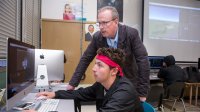Reducing Student Anxiety About Creative Digital Work
When students feel comfortable sharing creative work on open-ended projects, they’re better able to show what they know.
Your content has been saved!
Go to My Saved Content.“Did I do it right?”
“Can you check my work?”
“Is there an example I can look at?”
As educators, we often hear these questions from students, especially when creative technology tasks like video creation, podcasting, or digital design projects are assigned.
The two of us have worked hard to integrate open-ended projects into our curriculum that showcase students’ creativity and voice, as well as encourage out of the box thinking. Technology offers new opportunities for our students to express their thoughts and mastery of concepts in the classroom. From Flipgrid videos to more complex projects, this work can at times require students to share a piece of themselves. Every video, picture, voice recording, or digital product provides a tiny peek into students’ lives.
Many jump at the chance to work on these projects, but others are challenged in uncomfortable, anxiety-inducing ways that can impact their performance. Helping our students show what they know, even when they’re nervous about doing so, is ultimately our goal as educators. While we can’t remove anxiety altogether for students struggling with more open-ended creative digital projects, we can make choices as educators to help them manage it.
Employ Universal Design for Learning
Universal Design for Learning (UDL) has become an instructional planning staple in our classrooms, serving as a catalyst to implement various modes of creative sharing to challenge and support students. We believe the strength of UDL lies in how it supports learner variability by providing options when and where needed.
The UDL principle of engagement challenges us to think deeply about protecting our learners when sharing creative projects. Sarah has found that some students thrive when exhibiting their creative work, while for others the social demands of presenting can feel daunting.
To reduce creative anxiety around digital projects, Sarah encourages:
- Meeting one-on-one with students to discuss concerns and identify alternate ways of sharing their work.
- Using small group “showcases” vs. full class or public screenings of projects to ease anxious students into sharing their work publicly.
- Leveraging flexible room setups so learners can present their work in comfortable, authentic ways; students in Sarah’s classes often sit on the floor, rearrange desks and chairs, or create their own spaces around the classroom.
- Offering the option to create screencasts of student work if live presentations aren’t necessary.
Robert Wheatley, a middle school teacher we work with, suggests “adding in different modes of presentation: in front of class, in office hours, breakout rooms, or screen sharing.” Taking into consideration students’ comfort level when sharing work diminishes anxiety levels and helps them feel protected and empowered.
The UDL principle of action and expression encourages us to provide our students with different modes of creation to demonstrate learning. Offering students two or three tool choices with clear user guides keeps them from feeling overwhelmed by options. This gives students the opportunity to take action in a way they find comfortable and increases their confidence in the work they create.
When working remotely with middle school students, Emily let them choose to create a video, discussion post, or digital slideshow to show their understanding. In a recent digital storytelling project, Sarah gave her students the choice of a video, podcast, or photo essay.
Focus on What Is Being Measured
Try using backward design to align components of your creative projects with student learning outcomes, and ask yourself if these outcomes can be achieved by students in a variety of ways. CAST, the organization that developed UDL, suggests “considering how goals are articulated and communicated.” Goals with narrow definitions of learner success may “inadvertently privilege, exclude, and under-engage learners.”
Emily meets with students at the beginning of each project, collaborating on what learning outcomes are manageable, achievable, meaningful, and measurable. Defining these metrics together builds student confidence and provides direction.
Sarah never includes “creativity” in rubrics, but instead asks what successful student projects look like. What do we want students to be able to do at the end of the project? You can replace “creativity” on your rubric with critical thinking tasks like developing criteria, designing multiple solutions, or evaluating tools to meet project needs.
Our colleague Brenny Kummer creates sample products for students to critique using the rubric, focusing on project outcomes for improvement. Brenny also assigns regular reflections throughout the project to help students reflect on the process and see the progress they’re making over time.
Leverage Group Work
Students benefit from hearing a range of voices and ideas while producing creative work—from the brainstorming stage to creation of the final product. In our classrooms, we’ve observed that seeing examples of each other’s work and sharing ideas reduces students’ creative blocks and helps them become more comfortable with the creative process.
Group work on creative projects can:
- Provide a range of tasks, allowing students to focus on their strengths, and help them discover a role where they can confidently contribute.
- Create opportunities for group or community stories when sharing personal stories might make a student feel too vulnerable.
- Balance freedom and ownership with clearly structured tasks.
- Add a fun factor.
The growing use of creative digital projects in online and blended learning has left many students feeling anxious. Utilizing strategies to accommodate creative diversity encourages a safer learning space for all students to create, no matter where they fall on the creative spectrum. Ultimately, we can foster new opportunities for our students to build their confidence and grow through creative self-expression, even in spite of their anxiety.
